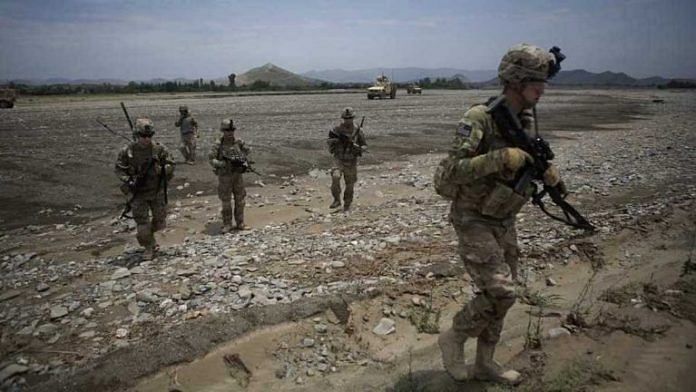
Thank you dear subscribers, we are overwhelmed with your response.
Your Turn is a unique section from ThePrint featuring points of view from its subscribers. If you are a subscriber, have a point of view, please send it to us. If not, do subscribe here: https://theprint.in/
“That’s one small step for a man, one giant leap for mankind.” When Neil Armstrong stepped on the lunar surface in 1969, the United States raced ahead of the erstwhile Soviet Union, so much so that no other country has been able to recreate that feat of nationalist fervour to date.
Nothing better could describe the ‘farsighted’ American approach, which keeps it ahead of others, be it sophisticated technological advancements, championing the holy grail of human rights, and sometimes invading a rugged terrain ‘somewhere’ in Asia, being its custodian for two decades, stepping back swiftly and waning into the oblivion. Surely, like Armstrong’s ‘one small step’, the retreating American boot has become a symbol of ‘one giant leap’ for the people of Afghanistan – into the dark ages.
Kabul has fallen into the hands of a pretentiously ‘good’ Taliban and a big churn has
begun with the re-emergence of Northern Alliance. The future holds the fate as many
more regional players intend to jump in for exploits. Amidst such a chain of events, a
steep dive into the sands of time becomes obligatory to understand the making of a
blunder stamped with a ‘Made in America’ logo.
A series of blunders
The last quarter of 2001 rings a bell of chaos and tragedy. Following the death of
Afghan warlord, Ahmad Shah Massoud, the city of New York had to face the brunt of
9/11. These events shook the anti-Taliban forces and the United States to the core.
With the combined wrath of American airpower and guerrilla tactics of the Northern
Alliance on ground, the Taliban regime was easily toppled.
However, the succeeding incident which took place in the city of Kunduz made the
early gains of the anti-Taliban forces pointless in the long run. Rumours of a ‘secret
flight’ between the northern town of Kunduz in Afghanistan and Pakistan started
circulating in media circles. According to various intelligence inputs, the Pakistani
establishment had struck a dubious deal with its American counterpart to airlift its
assets from Afghanistan.
It is speculated that under the garb of ‘asset evacuation’, the Taliban and Al-Qaeda
leadership was flown off to Pakistan without the knowledge of the Americans. The
official statements given by both parties reject this claim. However, there is enough
evidence available to dismiss the ‘myth’ of the event being a conspiracy theory hatched
by some over-enthusiastic dunderhead.
The real question isn’t whether such an incident took place or not, but whether the
Americans got hoodwinked by their Pakistani counterparts or were complicit in the act
themselves. When it comes to the Cheney-Bush duo, conspiracies seem more plausible
than official statements. Iraq is witness to it.
Furthermore, the search for Osama bin Laden from the heights of Tora Bora in
Afghanistan to the fortifications of Abbottabad in Pakistan is marred with questionable
conduct. First, had the Al-Qaeda chief been eliminated in Tora Bora, the American
taxpayer and the Afghan citizen would have been living in a different world altogether.
Second, it is amusing to think that for a decade, bin Laden was living under the nose of
the Inter-Services Intelligence. Third, it is even more amusing that the CIA got duped
by an agency it had been closely working with.
The ‘good Taliban’ itch
It is well known that the current political head of the Taliban, Mullah Abdul Ghani
Baradar, was released from Pakistani prison by the Americans to strike a ‘peace’ deal
before withdrawal. What happened next is open to the naked eye. From the very
beginning, it was expected of the Taliban to play a crucial role in Afghan politics after
American withdrawal, because the group may be a force of rag-tag extremists, but it
also has a well-structured leadership capable enough to throw in some political might.
The sudden retreat of American forces has left a huge void in Afghanistan. The stock
of ammunition and weaponry left behind, the sneaky betrayal of the American forces at
Bagram, and the ‘resistance’ shown by the American-trained Afghan Army speak
volumes about something that is being overlooked and needs thorough attention. Is it
purely a case of consistent miscalculations on America’s part, or is there another
‘conspiracy’ behind it?
There is a certain itch in American foreign policy which asks it to intervene in almost
every conflict across the globe, be it the jungles of Vietnam, the rugged terrain of
Afghanistan, or the ‘nuclear-armed’ installations of Iraq. America has seen it all, it has
done it all. But at what cost?
These pieces are being published as they have been received – they have not been edited/fact-checked by ThePrint.

COMMENTS